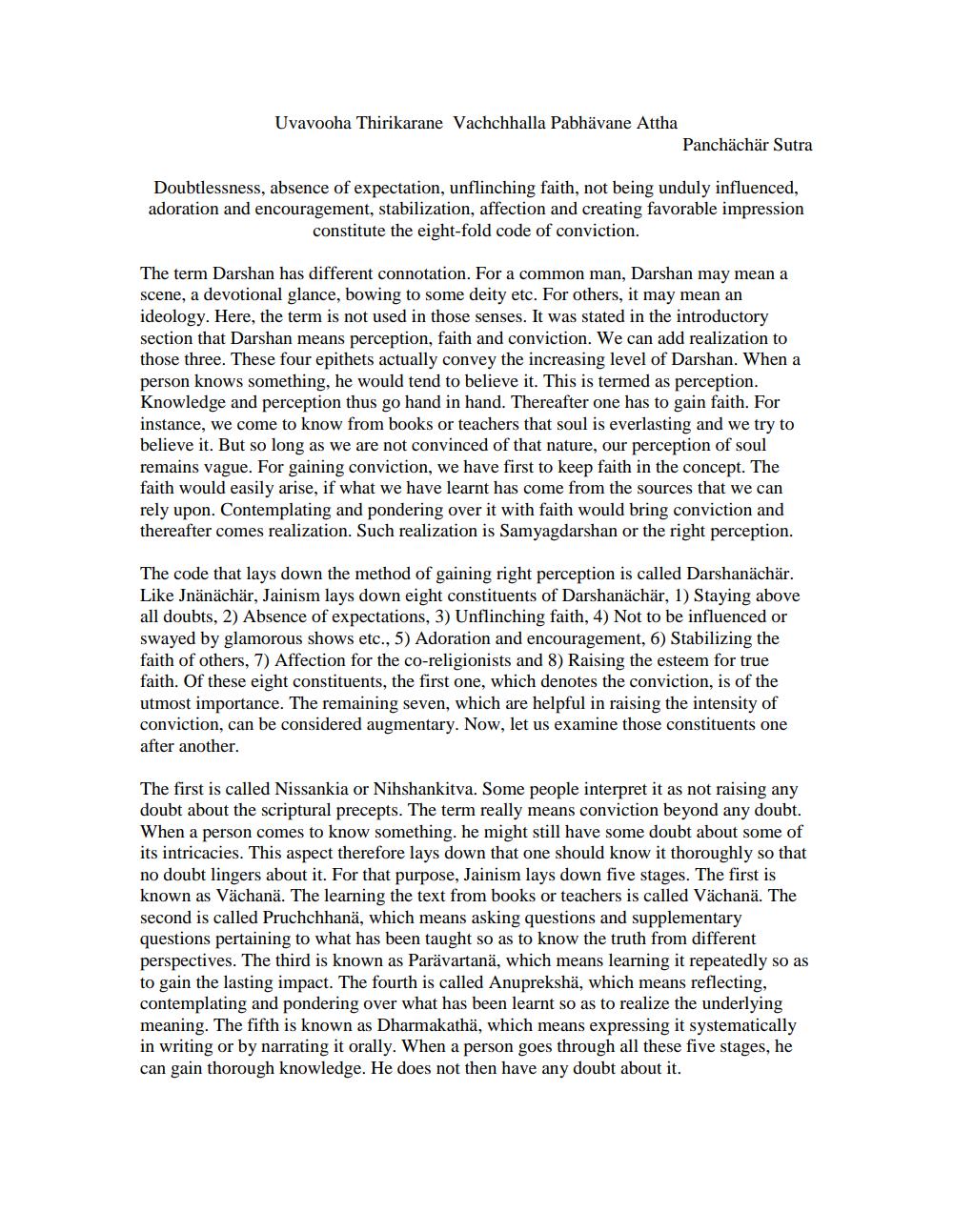Book Title: Spiritual Code and Restraints Author(s): Manu Doshi Publisher: Manu Doshi View full book textPage 7
________________ Uvavooha Thirikarane Vachchhalla Pabhävane Attha Panchächär Sutra Doubtlessness, absence of expectation, unflinching faith, not being unduly influenced, adoration and encouragement, stabilization, affection and creating favorable impression constitute the eight-fold code of conviction. The term Darshan has different connotation. For a common man, Darshan may mean a scene, a devotional glance, bowing to some deity etc. For others, it may mean an ideology. Here, the term is not used in those senses. It was stated in the introductory section that Darshan means perception, faith and conviction. We can add realization to those three. These four epithets actually convey the increasing level of Darshan. When a person knows something, he would tend to believe it. This is termed as perception. Knowledge and perception thus go hand in hand. Thereafter one has to gain faith. For instance, we come to know from books or teachers that soul is everlasting and we try to believe it. But so long as we are not convinced of that nature, our perception of soul remains vague. For gaining conviction, we have first to keep faith in the concept. The faith would easily arise, if what we have learnt has come from the sources that we can rely upon. Contemplating and pondering over it with faith would bring conviction and thereafter comes realization. Such realization is Samyagdarshan or the right perception. The code that lays down the method of gaining right perception is called Darshanächär. Like Jnänächär, Jainism lays down eight constituents of Darshanächär, 1) Staying above all doubts, 2) Absence of expectations, 3) Unflinching faith, 4) Not to be influenced or swayed by glamorous shows etc., 5) Adoration and encouragement, 6) Stabilizing the faith of others, 7) Affection for the co-religionists and 8) Raising the esteem for true faith. Of these eight constituents, the first one, which denotes the conviction, is of the utmost importance. The remaining seven, which are helpful in raising the intensity of conviction, can be considered augmentary. Now, let us examine those constituents one after another. The first is called Nissankia or Nihshankitva. Some people interpret it as not raising any doubt about the scriptural precepts. The term really means conviction beyond any doubt. When a person comes to know something. he might still have some doubt about some of its intricacies. This aspect therefore lays down that one should know it thoroughly so that no doubt lingers about it. For that purpose, Jainism lays down five stages. The first is known as Vächanä. The learning the text from books or teachers is called Vächanä. The second is called Pruchchhanä, which means asking questions and supplementary questions pertaining to what has been taught so as to know the truth from different perspectives. The third is known as Parävartanä, which means learning it repeatedly so as to gain the lasting impact. The fourth is called Anuprekshä, which means reflecting, contemplating and pondering over what has been learnt so as to realize the underlying meaning. The fifth is known as Dharmakathä, which means expressing it systematically in writing or by narrating it orally. When a person goes through all these five stages, he can gain thorough knowledge. He does not then have any doubt about it.Page Navigation
1 ... 5 6 7 8 9 10 11 12 13 14 15 16 17 18 19 20 21 22 23 24 25 26 27 28 29 30 31 32 33 34 35 36 37 38 39 40 41 42 43 44 45 46 47 48 49 50 51 52 53 54 55 56 57 58 59 60 61 62 63 64 65 66 67 68 69
